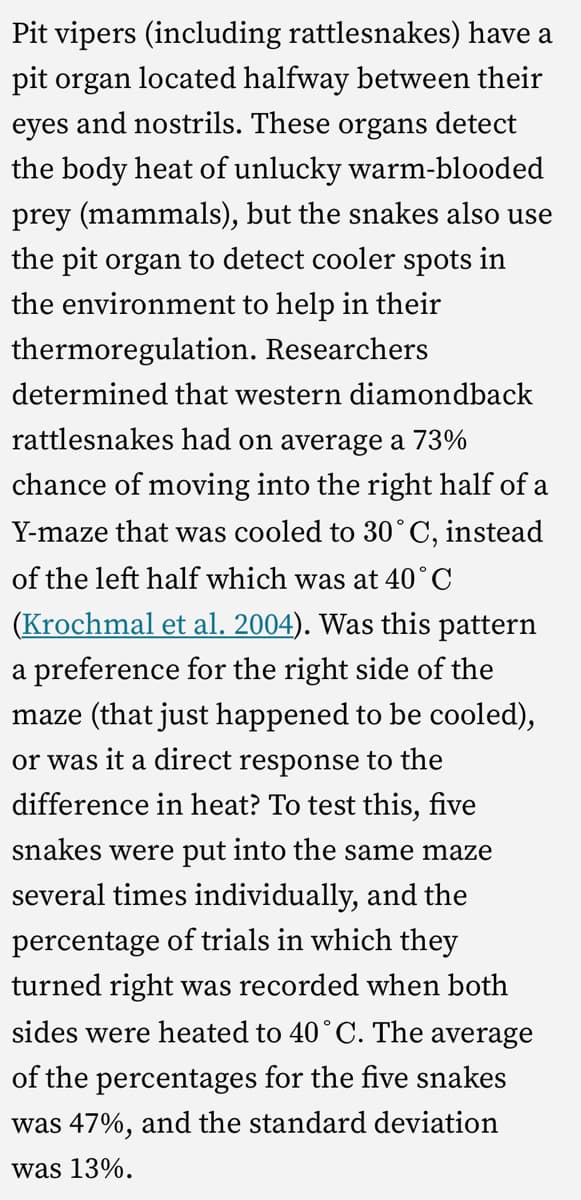Pit vipers (including rattlesnakes) have a pit organ located halfway between their eyes and nostrils. These organs detect the body heat of unlucky warm-blooded prey (mammals), but the snakes also use the pit organ to detect cooler spots in the environment to help in their thermoregulation. Researchers determined that western diamondback rattlesnakes had on average a 73% chance of moving into the right half of a Y-maze that was cooled to 30°C, instead of the left half which was at 40°C (Krochmal et al. 2004). Was this pattern a preference for the right side of the maze (that just happened to be cooled), or was it a direct response to the difference in heat? To test this, five snakes were put into the same maze several times individually, and the percentage of trials in which they turned right was recorded when both sides were heated to 40° C. The average of the percentages for the five snakes was 47%, and the standard deviation was 13%.
Pit vipers (including rattlesnakes) have a pit organ located halfway between their eyes and nostrils. These organs detect the body heat of unlucky warm-blooded prey (mammals), but the snakes also use the pit organ to detect cooler spots in the environment to help in their thermoregulation. Researchers determined that western diamondback rattlesnakes had on average a 73% chance of moving into the right half of a Y-maze that was cooled to 30°C, instead of the left half which was at 40°C (Krochmal et al. 2004). Was this pattern a preference for the right side of the maze (that just happened to be cooled), or was it a direct response to the difference in heat? To test this, five snakes were put into the same maze several times individually, and the percentage of trials in which they turned right was recorded when both sides were heated to 40° C. The average of the percentages for the five snakes was 47%, and the standard deviation was 13%.
Glencoe Algebra 1, Student Edition, 9780079039897, 0079039898, 2018
18th Edition
ISBN:9780079039897
Author:Carter
Publisher:Carter
Chapter10: Statistics
Section10.6: Summarizing Categorical Data
Problem 27PPS
Related questions
Question
100%
A. Is there a preference for the right side of the maze when the temperature is equalized? Test the null hypothesis that the mean percentage of right turns is 50% in this population. Assume that the distribution of scores was normal.
B. Can you think of a way to design the experiment to test effects of temperature so that side preferences, if present, do not affect the outcome?

Transcribed Image Text:Pit vipers (including rattlesnakes) have a
pit organ located halfway between their
eyes and nostrils. These organs detect
the body heat of unlucky warm-blooded
prey (mammals), but the snakes also use
the pit organ to detect cooler spots in
the environment to help in their
thermoregulation. Researchers
determined that western diamondback
rattlesnakes had on average a 73%
chance of moving into the right half of a
Y-maze that was cooled to 30°C, instead
of the left half which was at 40°C
(Krochmal et al. 2004). Was this pattern
a preference for the right side of the
maze (that just happened to be cooled),
or was it a direct response to the
difference in heat? To test this, five
snakes were put into the same maze
several times individually, and the
percentage of trials in which they
turned right was recorded when both
sides were heated to 40° C. The average
of the percentages for the five snakes
was 47%, and the standard deviation
was 13%.
Expert Solution
This question has been solved!
Explore an expertly crafted, step-by-step solution for a thorough understanding of key concepts.
This is a popular solution!
Trending now
This is a popular solution!
Step by step
Solved in 2 steps with 1 images

Recommended textbooks for you

Glencoe Algebra 1, Student Edition, 9780079039897…
Algebra
ISBN:
9780079039897
Author:
Carter
Publisher:
McGraw Hill

Glencoe Algebra 1, Student Edition, 9780079039897…
Algebra
ISBN:
9780079039897
Author:
Carter
Publisher:
McGraw Hill